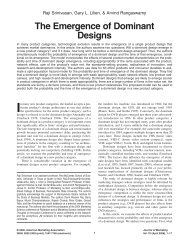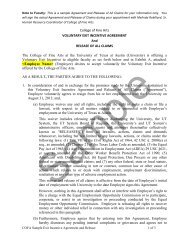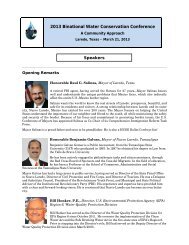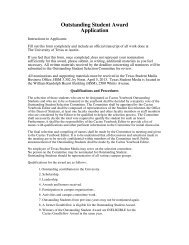Invited Talks: Transition Metal Oxides - University Blog Service - The ...
Invited Talks: Transition Metal Oxides - University Blog Service - The ...
Invited Talks: Transition Metal Oxides - University Blog Service - The ...
Create successful ePaper yourself
Turn your PDF publications into a flip-book with our unique Google optimized e-Paper software.
<strong>The</strong> John B. Goodenough Symposium in Materials Science & Engineering –<br />
In Honor of His 90 th Birthday<br />
<strong>The</strong> <strong>University</strong> of Texas at Austin, Austin, Texas<br />
October 26-27, 2012<br />
Novel Cathode and Anode Materials for Solid Oxide Fuel Cells<br />
Matthew West, 1 Daeil Yoon, 2 and Arumugam Manthiram 1,2<br />
1 Department of Chemical Engineering and 2 Materials Science and Engineering Program<br />
<strong>The</strong> <strong>University</strong> of Texas at Austin, Austin, TX<br />
Email: manth@austin.utexas.edu Website: http://www.me.utexas.edu/~manthiram<br />
Abstract Body in Space Below:<br />
(Please use single space, Times New Roman or similar font, size 12, and limit to 250 Words. Please DO NOT exceed the space<br />
below.)<br />
Solid oxides fuel cells (SOFCs) offer great promise for future energy production due to their high<br />
efficiencies and fuel flexibility. Despite their benefits, the commercialization of SOFCs is hampered by<br />
severe materials challenges, and there is significant interest in reducing their operating temperatures from<br />
the conventional > 800 o C to an intermediate range of 500 o C – 800 o C and in utilizing hydrocarbon fuels<br />
like natural gas directly instead of hydrogen fuel. We present here the development of new materials and<br />
novel synthesis approaches to address some of these issues. A new series of cathode materials RBaM 4 O 7<br />
(R = rare earth) identified in our group exhibits good catalytic activity with an ideal matching of the<br />
thermal expansion coefficient to that of conventional electrolytes like YSZ. However, the RBaM 4 O 7 series<br />
suffers from long-term stability issues, and attempts to improve stability often come at the expense of<br />
reduced catalytic activity for the oxygen reduction reaction. Through appropriate cationic substitutions<br />
with small amount of dopants in the crystal lattice, we have been able to resolve the stability issues<br />
without significantly sacrificing the electrochemical performance. As for the anode, the oxidation of<br />
hydrocarbon fuels on conventional Ni-YSZ catalyst is accompanied by carbon deposition on Ni, resulting<br />
in a reduction in catalytic activity and overall life expectancy of the cell. To alleviate these problems and<br />
enhance the performance of SOFC anodes, both heterogeneous anode catalysts and new synthesis<br />
techniques for traditional materials are being investigated.
















